
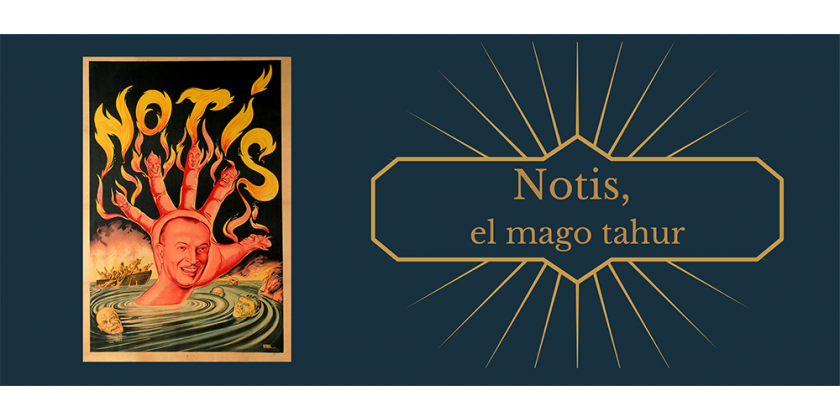
Notis, the magician gambler
The Bait
I am a fish under water. Searching. Permanently. My nourishment is the history of magic, its secrets above all: the unknown; that which is still blank in the books. I see a clue, just a flash, and I run after it. Many times it is just a dot on a drawing. When I was just a child, there were some puzzles in the magazines, in which, after linking several dots a figure was revealed. All the points were already there, but in the case of the history of Magic in Argentina, the challenge is that they aren'r all together. The clues, that is, the dots appear little by little; the drawing is evolving until one day I can see "almost" complete the figure. I draw back a veil from the story, then I pass to another level of the game. I savor the pleasure of my discovery and then I face a thousand more queries.
Notis
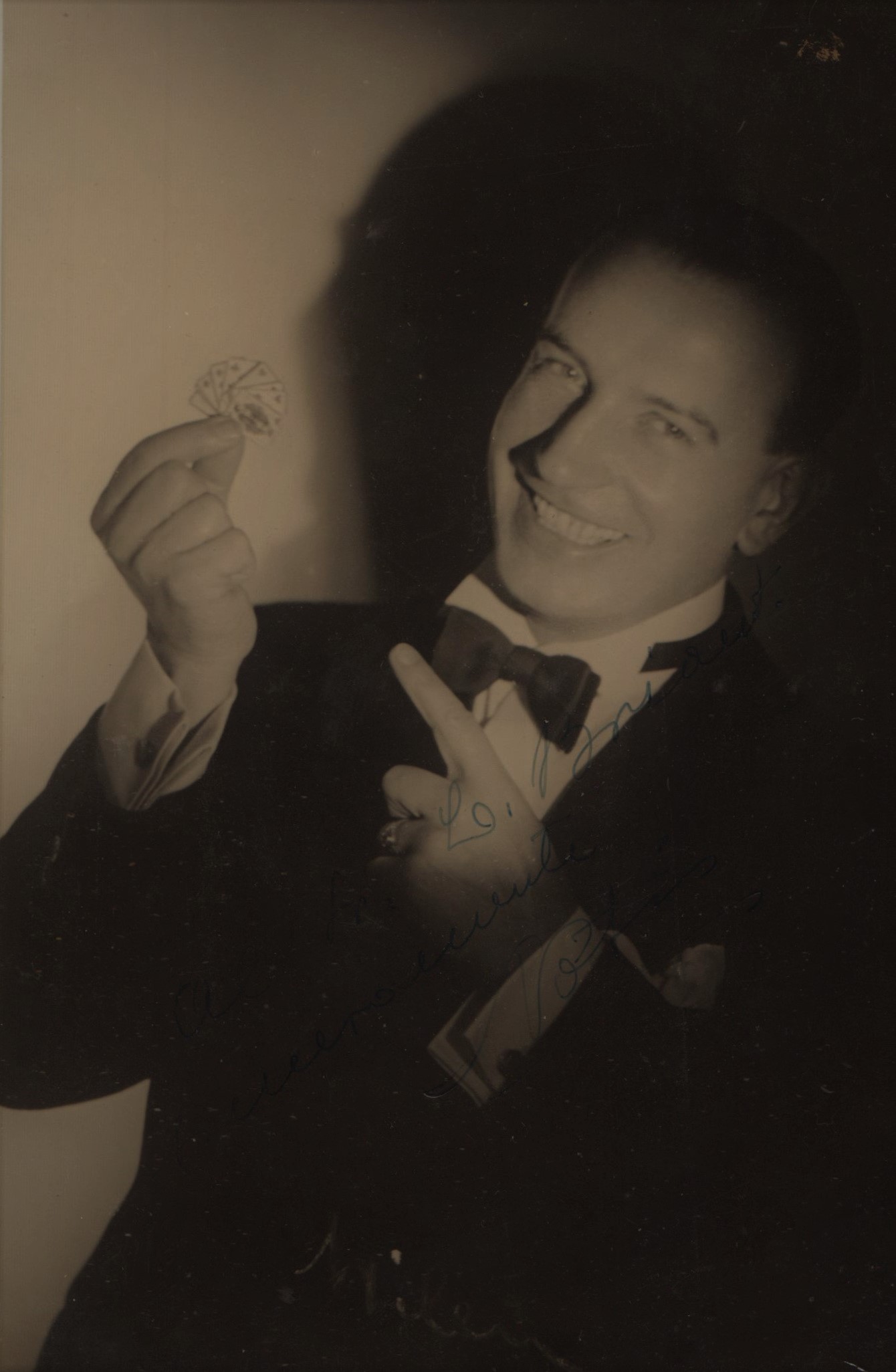
Mario Vigna, Professor Notis - Martin Pacheco Colection
If my teacher, whom I deeply admired and still admire, chose the name Notis to form his name, Notis must have been a very special magician. That brief talk with Kartis was the kick to start this little investigation that I share now in the El Baúl de Don Cayetano (Don Cayetano's Trunk). Over the years I learned that Dai Vernon [ii], on one of his trips to our country, met Notis and was amazed at his technique. The Professor left a record of those methods in some of his books, where he rescued two techniques of this magician (Notis). Lewis Ganson [iii], in his books on Dai Vernon, developed both techniques: the first one, 'Stop Trick', published in Dai Vernon's Inner Secrets of Card Magic; the second one, 'CascadeTrick', published in Dai Vernon's More Inner Secrets of Card Magic.
I found the first mentions about Notis in some programs of Magic Conferences in Argentina, as well as in the old catalog of El Palacio de la Magia Moderna (The Palace of Modern Magic) [iv] —where he is mentioned as an advisor—.
I remember when in 2007, working on cataloging my poster collection, I found that I had a Notis poster; but then I faced a problem: I realized that didn't know his real name. I had heard that he was Italian, but that fact alone seemed insufficient to me. I called several magicians from his time; however, none of them could remember his name.
During that period I found another clue, which made me follow another lead. In The Sphinx [v] magazine, Leslie Briant [vi] contributed, writing from Argentina, the news of magic from this side of the world. Leslie was English, residing in Argentina, and was part of the group of English magicians, along with Frank Cleaver [vii] and Kenneth Murray, [viii] who obviously congregated around Fu Manchu [ix], and they were his closed circle of friends .
Returning to Leslie, his great legacy was to have written for years, in the world famous magazine The Sphinx, a column on magic in South America, where he left a record of valuable information for the history of magic.
In 1946 Leslie published a note in which he reveald who was the man behind the magician. Mario Vigna was Professor Notis.
Little by little the gaps were filled. I confirmed that he had been born in Italy and that his specialty was card magic. That was enough for me at that moment, because then I was overwhelmed by other investigations. At the time, I did not appreciate some data that seemed to me of little relevance, but finally they would lead me to fill in many of the gaps in the history of Notis.
A few months ago I read the note again, already with the idea of writing this article, and found that those data, ignored in my haste, were more than interesting and they became central to this writing. I share some fragments of the note with you:
“His manipulation is perfect and he combines a certain amount of juggling with his magic. For example, he will take three cards and juggle them as easily as others do with three balls or three clubs. He throws one card after another around the auditorium until he has three, four, and five in constant flight, one by one returning straight to his hand. Notis performs the pass with one hand in ten different ways, and not only that, but he does it simultaneously with both hands. It's possible that others may do the same, but Notis makes it better."
“Notis, in a supposed improvisation, balances a coffee spoon on his nose while the cards flicker under his nimble fingers. He claims to be the only person in the world who can perform this feat.”
“Some of his tricks certainly follow the usual pattern, but with an original twist and with baffling variations. He will do a version of the four ace trick using only the sixteen cards, without fake cards and with an invisible technique”.
"He also performs the 'Out of this World' effect but in a way inconceived by the inventor."
“I practice at least four hours every day, sometimes more, and I have always done so. For me it is a passion, it is not a job.
“About Erdnase's [x] book, he said with justifiable pride: 'I took it easy and added effects and manipulations on top of that' ”.

At the end of the text, Leslie mentions that Notis was a main character in a novel by a Spanish writer. I saw the shiny fishhook again. Leslie had not read the novel; surely this was told to him by Notis, but his intuition made him to quote the title and author in her note: La conquistadora de América, by Adelardo Fernández Arias [xi].
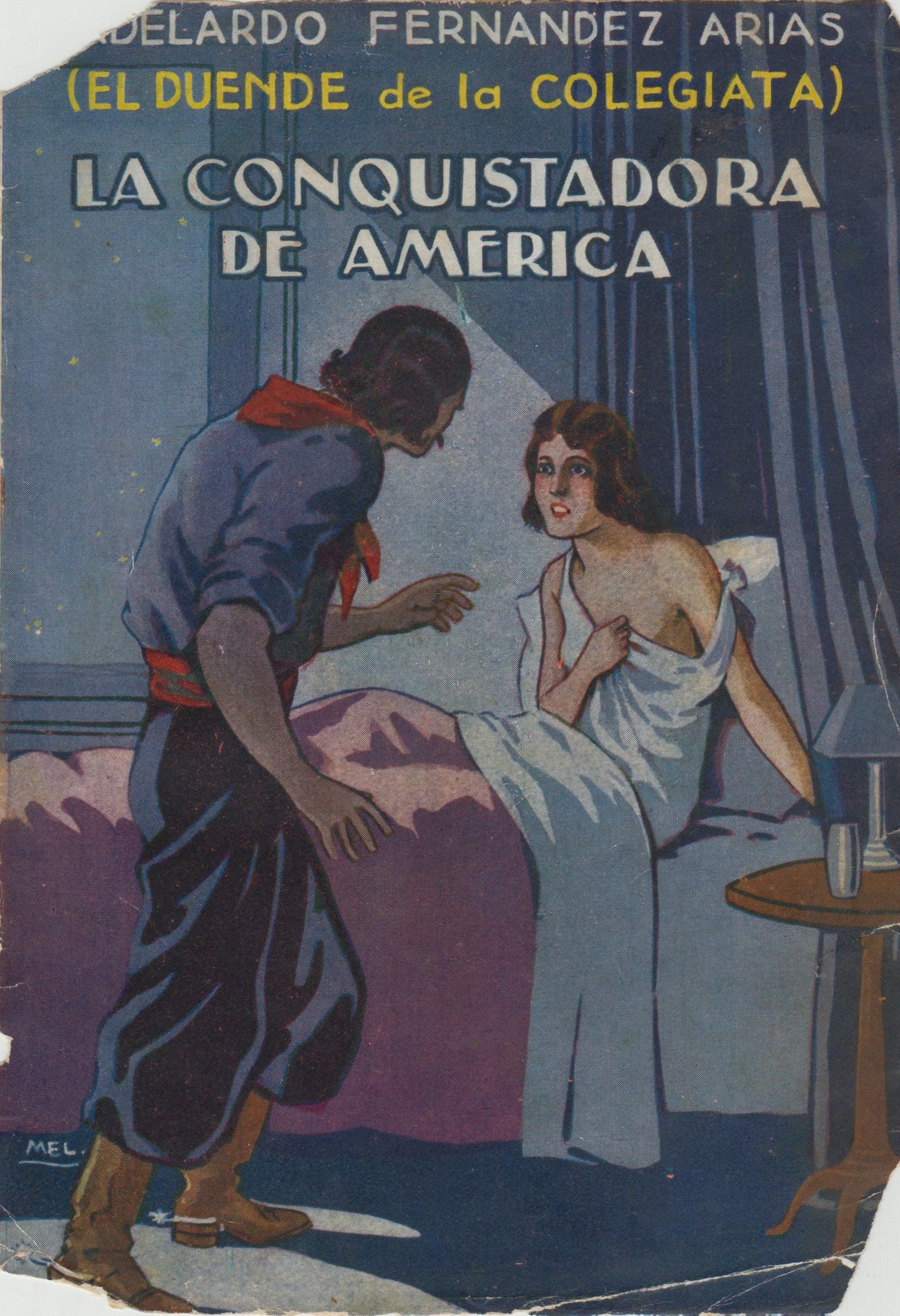
I had to get that book - something else from Notis might appear in there - I had to read it and I did. The book was published only once in 1931, in Madrid, and is almost an autobiography of its author, where he recounts his hardships in an attempt to get rich in Argentina, imitating what many immigrants and compatriots achieved. Anxiety was eating me. Please believe me. When these things happen to me, when a clue appears and then I follow it finding an end, the adrenaline it generated makes me lose sleep. I began to read it, or rather to devour it, anticipating when Notis would appear; what place he would occupy in the story. The chapters were passing and he had not appeared yet. A travel chronicle, a truncated love story, in a book almost 100 years old, with yellow and rough pages, that promised me heaven but it seemed that it never came. But the prize was there. Reaching the middle of the story, the protagonist finally meets Notis on a trip through Mesopotamia and becomes his artistic representative. There are practically two chapters dedicated to telling the life of the magician and his show. All was information unknown until now. The pages start turning too fast, now I didn't want them to end.
The Notis show
This book, until now lost for the reading of magicians, tells us in detail the Notis show. This lasted two hours and could be presented on any type of stage and scenery. He was traveling with only two suitcases: one for his personal effects and one for his magic. This alone was what he needed to present his show, allowing him to perform anywhere with ease. He appeared on stage in a perfect tailcoat and used to play with his Italianized Spanish. He used this resource with great charm and it quickly allowed him to win over the public. He was a very young magician in those years. The story takes place in the twenties and he was not more than twenty-five years old.Quite a curiosity for the time.
His show was divided into three parts: the first included card tricks, and here the author of the novel coincides with the other already known reports in which it is stated that his skill was striking. Notis was an innovator in introducing card magic on the stage. In those years the magicians who arrived in Argentina toured its theaters with large apparatus and illusions, often with companies of dozens of people. Notis presented what is known today as a one-man show; he was an innovator.
The second and third parts bring another hitherto unknown peculiarity: Notis presented thought transmission effects with the public, ending with hypnosis. Although this resource was widely used during those years by theatrical mentalists, it was not until the reading of The Conqueror of America, that it was not known that Notis used mentalism in his shows.
His show was very profitable for him. He agreed with the theatre managers to get fifty percent, while they had to take care of advertising. He also used to do his part in the publicity by visiting the local newspapers and doing his card tricks to the chroniclers, who paid for his astonishment with stories that drove the public to the theaters. He didn't do more than two performances a week and always to a packed house. He moved quickly from city to city, which allowed him to return again in a short time without saturating the town. Managers loved his show because it was simple: he needed no set up or break down, just one person on stage. The public enjoyed it and there was a good profit. All this made it a great business. He used to give precise instructions to his representative, who went ahead in the cities.
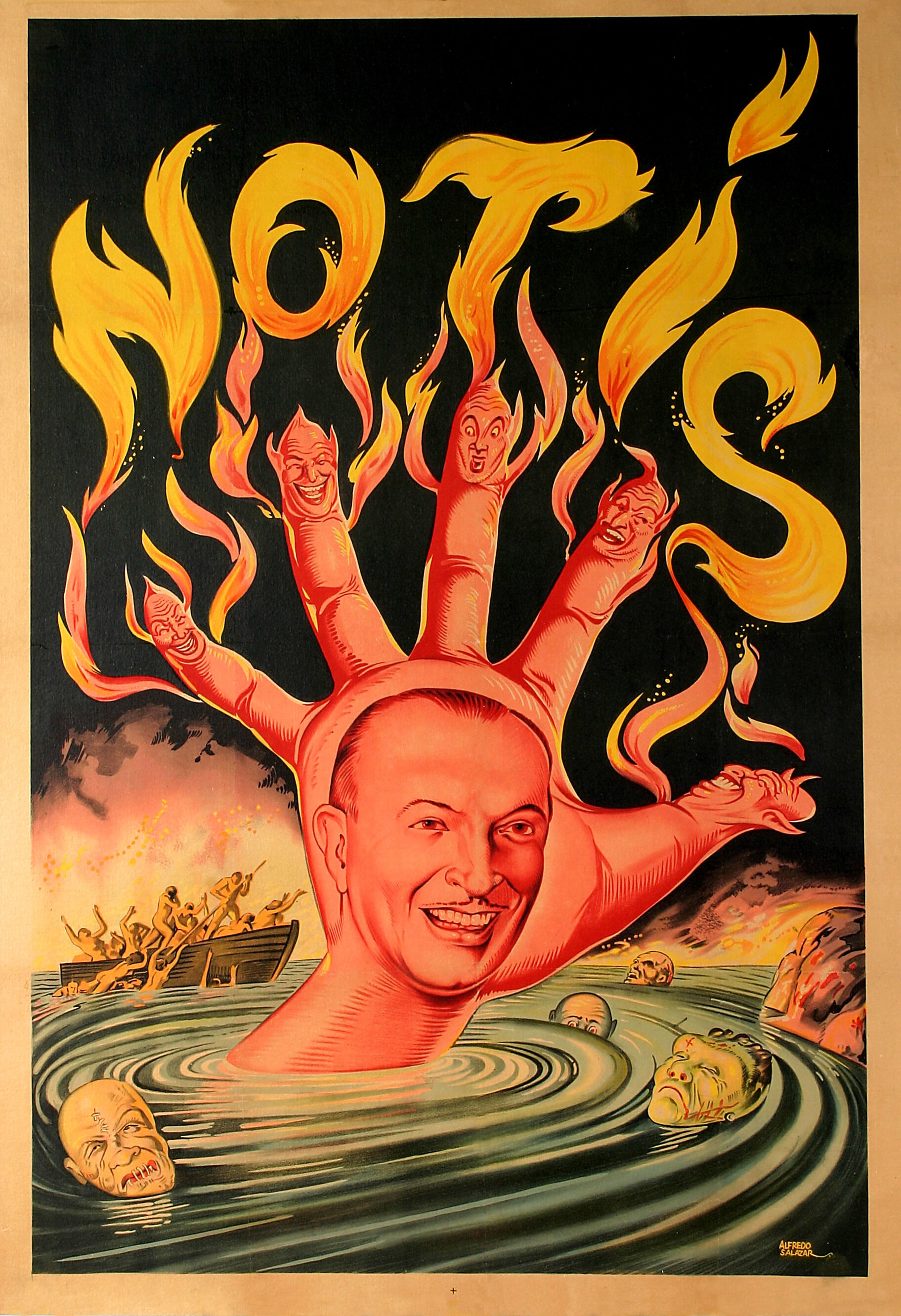 Only know poster of Professor Notis - Martin Pacheco Colection
Only know poster of Professor Notis - Martin Pacheco Colection
Cumberlandism and Hypnosis as Part of the Show
The book perfectly describes his act of Cumberlandism [xii] in two phases: Notis blindfolded himself and gave a flower to an spectator, chosen by another, and always ended, taken up his arm by a third spectator, finding a knife hidden by someone in the public. What follows in the book is the description of the method, where the author explains the system used by Notis, an disloyalty that surely the magician never imagined. The technique described is the classic one of cumberlandismo, which gives veracity to all the story of the author.
The hypnosis was performed with a series of preselected spectators. This technique was very common at the time with theatrical mentalists. Twenty spectators would get on stage and Notis would make a selection of four or five. The ones that remained were the shortlisted before the show.
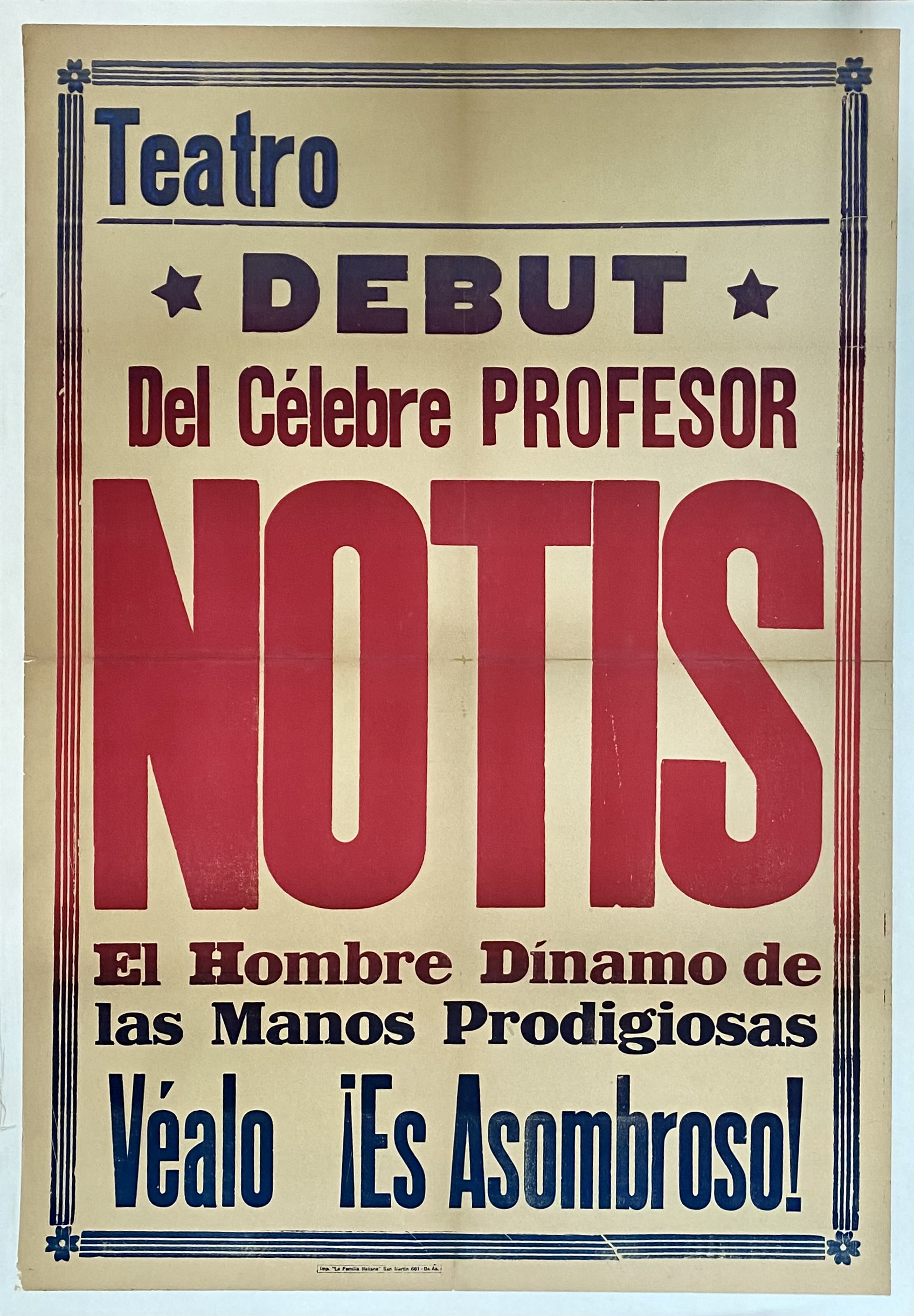 Only know poster of a Professor Notis show - Martin Pacheco Colection
Only know poster of a Professor Notis show - Martin Pacheco Colection
The Gambler
During a trip to Paraguay from Corrientes, Notis asked his representative if he knew how to play poker. He this replied: I
know it, I don't play it.
"But do you know the hands: full house, four of a kind, straight?" I only need this. Poker tables are always set up on the ship. I can control everything with a deck of cards, deal the hand I want to whoever I want —it seems that our friend has undoubtedly read the Erdnase— and I prefer that you be the one who receives it and not me, do you understand me?
In this way, Notis was presented in a new facet, that of a gambler.
The account of the poker game where Notis cheats is fantastic and that alone is worth reading the book. He warned his buddy that he would only cheat about twice during the game, once he had understood the psychology of the other players and, to leave his partner alone, he just told him:
"When you get a good hand, just look at which hand I have my ring in: if it's on the right, bet it all with ease." You will be rewarded fifty percent.
With these words he closed the deal.
The Poker Game in the Words of the Author of the Book:
Notis, from the first moment, did everything possible to lose. Moreover, even when he casually had good cards in hand with which he could make a good game, he intentionally forced all his intention to lose, and when he had already lost some money, he exclaimed with the greatest cynicism:
—You will have observed that I do not conceal any card for my own benefit; On the contrary, now I am beginning to suspect if any of you is competing with me. They all laughed at Notis' occurrences and the game continued, without anyone worrying anymore about the remote possibility or had the faintest suspicion regarding Notis using sleight-of-hand in that game.
Carlos played as the game came: in alternative gains and losses. Suddenly, Carlos found in his hand a poker of aces. He was instinctively excited; he looked at Notis and observed, indeed, that the conjurer, very surreptitiously, passed his ring to his other hand.
In front of Carlos, a player made a wager. Carlos accepted it. His opponent doubled the bet, which was accepted by Carlos. The cards were revealed. The player in front of Notis had "flush". Carlos had poker of aces. He had won. They all laughed. Notis, facing Carlos, said to him:
Oh come on! So, are you the one who is using sleight of hand? What a rich guy!
Carlos paled; without his being to blame for what was happening, he felt accomplice in something that was not honest, something that was not fair. He got up to get a drink and to react. The game continued. Indeed, as Notis had announced, that trick was repeated two or three times, but so well distributed throughout the game that no one suspected what was happening.
When they arrived in the capital of Paraguay, at the hotel, Notis smilingly told Carlos:
"You can't complain. We have earned seven hundred pesos; that is, three hundred and fifty each; I think it's not bad.
Carlos, upon handing over the three hundred and fifty pesos that belonged to Notis, somewhat troubled, murmured.
—Yes, but all this is very difficult for me.
Notis, laughing, exclaimed:
—You'll get used to it, here in America one gets used to everything, believe me. America is a great country!
The book continues recounting the adventures of Notis and his representative in Argentina, where the artistic success he had in our lands is always highlighted.
.jpg) Visa for work of Professor Notis
Visa for work of Professor Notis
Way Still to Go
Notis was born in Turin, Italy, on the 21st of February, 1900. The Escamoteo magazine of Argentina and other magical publications all over the world echoed the news about his demise. Professor Notis passed away on the 8th of November, 1953. Information about him fades in recent years. Nothing else has been written about Notis up to this day.
When I acquired the poster that illustrates this note, I admired its beauty, its design, and I tried to imagine, looking at it, who Notis could have been.
A great deal of time had to elapse. It was necessary a combination of chance and wish, lure and desire, to raise the mantle that hid an important part of the history of Argentine magic. I'm happy, but I'm already looking for more glints, more clues to help me fill in the missing blanks.
I hope that this article is just the beginning, in order to write more chapters on the life of the man who was, without a doubt, the first card magician to set foot in our country.
Notes on the deadline:
When I had everything ready for publication, my friend Enrique Jiménez-Martínez sent me an obituary that appeared in Tops Magazine on February, 1954. It was written by Leslie Briant, and in it there is a mention about Notis, made by none other than San Horowitz (Mohamed Bey) [xiii] . I leave it here for you to enjoy...
"It was with feelings of intense sorrow and regret that I learned of the sudden death of my old friend, Prof. Notis, on my last voyage to Buenos Aires. During the scores of visits I have made to the River Plate, I had always found Notis to be a jolly, delightful companion and a skilled Magician. His car was always at my disposal and he did everything possible to make my stay at Buenos Aires enjoyable. Notis was the foremost card expert in South America, and indeed, few Magicians in North America possessed the dexterity in manipulation that Notis had. A sad feature of his death is that he had completed the necessary arrangements to spend one year in the United States, which was the ambition of his life."
CAYETANO, FEBRERO DE 2022
Notes:
[i] Artistic name of Enrique Carpinetti, Argentine magician. He was, among other things, the great master of magic of Argentina. Many of today's greatest magicians took their first lessons with him.
[ii] David Frederick Wingfield Verner (1894-1992), better known as Dai Vernon, was an illusionist born in Canada, but his magical career took place in the United States. He is known to magicians around the world as The Professor. He was one of the great world masters of close up and card magic.
[iii] Lewis Jack Ganson (1913-1980) was an English magician who became one of the most prolific writers on magic, writing more than sixty books on the subject.
[iv] El Palacio de la Magia Moderna (The Palace of Modern Magic), was a magic shop in Argentina, founded and directed by Jaques Mayer. One of his catalogs is possibly the most important catalog published in South America so far to this day.
[v] The Sphinx, An Independent Magazine for Magicians, was an English-language magical magazine published monthly, from March 1902 to March 1953, by William J. Hilliar. Its publication ended under the direction of John Mulholland. It was a very important magazine during the first 50 years of the 20th century.
[vi] Leslie Briant was an English amateur magician who lived in Argentina. His great legacy was having written the South America Notes column for years in The Sphinx, where he left a record of what happened in our lands.
[vii] Frank Cleaver, English by birth, lived for some years in Argentina. He was an amateur magician and a very important link with English-speaking magicians from all over the world.
[viii] Kenneth Murray, Argentine magician (1930-2014), was part of the English community in Argentina that made so many contributions to magic in our country.
[ix] Fu Manchu, David Bamberg (1904-1974) was Theo Bamberg "Okito's" son. Born in Great Britain and raised in the United States, he developed his entire artistic career in Spanish-speaking countries, having great success in Spain, Mexico and Argentina, the latter being the country he chose to begin his artistic career in 1929 and also the place where he lived until his last days. He was the last link and possibly the most precious of the seven generations of magicians of the Bamberg family.
[x] S. W. Erdnase is a pseudonym used by the author of The Expert at the Card Table, a book detailing with sleight of hand, cheating, and magic tricks using cards. Considered essential reading for any magician interested in card tricks, the book (generally known simply as Erdnase), first appeared in 1902. The true identity of the author of the Erdnase book is one of the enduring mysteries of the magical community.
[xi] Adelardo Fernández Arias (1880-1951), also known by the pseudonym El Duende de la Colegiata (The Goblin of the Colegiate Church), was a Spanish journalist, playwright, writer, publicist and film director.
[xii] Cumberlandism is a technique developed and used by magicians, which consists of reading involuntary muscle movements of a spectator. The term comes from the name of the magician Stuart Cumberland, who first devised a modern and recognized encoding for this type of experiment.
[xiii] Sam Leo Horowitz (1894-1971), who performed as Leo Hartz, Dr. Chung and Mohammed Bey, had a long professional career with great success on cruise ships. The Mohammed Bey name was suggested by Judson Cole because of his Turkish appearance.
Bibliographic references:
-
- The Sphinx Magazine- september 1946
- The Sphinx Magazine - marcho 1953, volume 52 numeber 1, página 45.
- La Conquistadora de América by Adelardo Fernandez Arias - Madrid 1931 (book in spanish)
- Dai Vernon’s Inner Card Secrets of Card Magic by Lewis Ganson - 1959 - chapter 7, The Notis Stop Trick
- Dai Vernon’s More Inner Card Secrets of Card Magic by Lewis Ganson - 1960 - chapter 5 , The Notis Cascade
- Catálogo del Palacio de la Magia Moderna, 1945. Buenos Aires, Argentina
- Escamoteo Magazine , Nº 4 - november de 1953 - Magic magazine in Spanish published in Argentina
- John Braun, The Linking Ring, September, 1954 (Vol. 34, No. 7), pages. 34-35
- John Braun: Of Legierdemaine and Diverse Juggling Snacks, A Salon de Magie por Ken Klosterman, 1999, page117
- Whaley, Bart, Who's Who in Magic. Jeff Busby Magic, Inc. Oakland, California, March, 1990, page 245.
- Waters, T. A., The Encyclopedia of Magic and Magicians. Facts on File Publications, New York, 1988, page 243.
- The Linking Ring, volume 33, number 11, january 1954, page 96
- Tops, february 1954, volume 19, num,ber 2, page 27.
- Abracadabra, 21 of novmber 1953, volume 16, number 408, page 280.
Acknowledgment
Roberto Mansilla - Pablo Zanatta - Wallas - Alex Nebur - Enrique Jimenez Martinez





.png)
.png)
Me encanto, muy buena la iniciativa. Y un descubrimiento para mi Notis, no lo conocía
Espectacular!
Genial, gracias por la info. Me encanta el poster de la mano, que veía en muchas de sus publicaciones y siempre me intrigó el personaje. Espero que sigan compartiendo este tipo de cosas. Felicitaciones
Muy bueno!!
Excelente resumen, muy bien narrado!! Muchas Gracias !!!!!
Excelente Martin! Siempre es fascinante leer y descubrir el camino que han transitado los/las Artistas que nos antecedieron. Mis Aplausos por la iniciativa!!!
Rottweiler köpekleri, <a href="https://kopekturleri.site/">kopekturleri</a> Rottweiler ın karakteristik özellikleri, sadık, zeki, itaatkar ve koruyucu olmasıdır. Bu köpekler genellikle ailelerine çok bağlıdırlar ve sürekli etrafta dolaşarak ailenin diğer üyelerini koruyarak en yakın arkadaşı, arkadaşları ve aileleriyle zaman geçirmekten hoşlanırlar. <a href="https://tr.wikipedia.org/wiki/Anasayfa">wikipedia</a> Maltese köpekleri, enerjik, cana yakın, sadık ve sevecen bir yapıya sahiptir. Bu sevimli köpekler, küçük yapısı ve muhteşem beyaz tüyleri ile dikkat çekerler. Ancak sağlık sorunlarına eğilimli oldukları için, düzensel veterinere kontrollerinin yapılması ve gerekli bakımların düzenli olarak yapılması önemlidir. Maltese köpekleri, genellikle evcil hayvan olarak tercih edilen oyuncak cins köpekler arasında yer almaktadırlar.